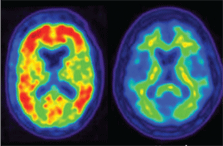 A 69-year-old white female presented to the office to establish care, after recently moving to the area. She was accompanied by her daughter, who took a very active part in her history and our discussion.
A 69-year-old white female presented to the office to establish care, after recently moving to the area. She was accompanied by her daughter, who took a very active part in her history and our discussion.
The patient had no visual complaints. Her ophthalmic history included bilateral lens extractions with IOL implantation two years ago. Her last visit to her previous provider was 18 months earlier. Her current medications included Celexa (citalopram, Forest Pharmaceuticals) HS, alprazolam QD, Mycardis (telmisartan, Boehringer Ingelheim) QD, low-dose (81mg) aspirin QD and fish oil supplements. She reported no allergies to any medications.
Ancillary history revealed that the patient had lost her husband approximately five years earlier. She had been living on her own in New York until, at the urging of her daughter, she moved to North Carolina. The daughter implied that her mother was becoming more forgetful over the past 18 months.
Also, my tech reported that, during the initial work-up, the daughter had mentioned a news story suggesting Alzheimer’s disease can be “detected with an eye exam.”
Diagnostic Data
The patient’s best-corrected visual acuity was 20/25 OD and 20/25- OS through minimally altered spectacle prescription. Pupils were reactive to light and accommodation, with the left pupil slightly oval in shape and slightly larger than right; no afferent defect was noted OU.
Slit lamp examination of the anterior segments was unremarkable. Angles were open to grade 4 OU. Intraocular pressure measured 15mm Hg OD and 22mm Hg OS at 10:18 AM. Pachymetry readings were 534μm OD and 540μm OS.
Upon dilated examination, IOLs were clear and centered in the capsular bags. The posterior capsule of the right eye was clear and intact; that of the left eye was opened on the visual axis consistent with a YAG capsulotomy. Vitreous separations were noted in both eyes.
Her optic discs were of average size, with cup-to-disc ratios of 0.35 x 0.45 OD and 0.45 x 0.55 OS. Both neuroretinal rims were robust and followed the ISNT rule, with perhaps just the slightest pallor to the temporal sectors. No focal thinning or notching was noted in either optic nerve. Retinal vasculature was remarkable for grade 2 arteriolarsclerotic retinopathy, with arteriovenous crossing changes along the arcades of both retinas.

| |
|
Alzheimer’s is usually diagnosed by cognitive and neurological tests, not eye exams. In PET scans, amyloid-beta plaques are highlighted in the Alzheimer’s brain (left), but are absent in the normal brain.
Image: University of California Berkeley
|
Given her presentation—a new patient with asymmetric pressures and slightly asymmetric optic nerve appearances, along with a slightly pale appearance to both optic nerves—I asked her to return in a month for threshold visual field studies, a repeat IOP measurement, gonioscopy and optic nerve imaging.
As I discussed these plans with the patient, her daughter finally asked the question I dreaded to hear: “Is there any sign of Alzheimer’s in my mother’s eyes?”
I briefly explained that Alzheimer’s is a complex neurodegerative disease that may have manifestations in the eye, but cannot be definitively diagnosed from an examination of the eye alone. I did stress that I didn’t yet have “all the pieces of the puzzle,” and that her mother certainly required further evaluation.
The patient, again with her daughter, returned as scheduled. Threshold fields were unremarkable, with good reliability indices. IOP was 17mm Hg OD and 22mm Hg OS at 11:00 AM. Gonioscopy showed open angles OU, with minimal trabecular pigmentation and no structural abnormalities. Heidelberg Retina Tomograph-3 imaging (HRT-3, Heidelberg Engineering) confirmed the earlier clinical description of the optic nerves and neuroretinal rims, and an OCT scan showed a normal retinal nerve fiber layer in each eye.
Diagnosis and Management
Given her findings—particularly the normal visual fields—I concluded that the mild pallor seen on physical examination was more consistent with pseudophakic disc pallor and not of neuro-ophthalmic origin. I diagnosed the patient as a low- to moderate-risk glaucoma suspect, and asked to see her back in six months.
The daughter again asked about Alzheimer’s and if I was seeing anything that was associated with it.
Discussion
Recently, news stories have trumpeted the idea that Alzheimer’s disease can be detected with an eye examination. These headlines caught the attention of many people. A similar news item was disseminated approximately 15 years ago. It reported that patients with Alzheimer’s disease had a higher likelihood of optic disc atrophy––which could be seen during an eye examination—and implied that people should have their eyes examined as a screening for Alzheimer’s.
But, these “eye-catching” headlines don’t tell the full story. There is yet no definitive ophthalmic test in clinical use that can conclusively diagnose Alzheimer’s disease. But, if you should face similar questioning by a patient or their family, a brief overview of the findings in recent studies may be helpful.
Because the optic nerve consists of ganglion cells linking the retina to the lateral geniculate nucleus and to the pupillary centers in the midbrain, it makes sense that the optic nerve fibers can at least be susceptible to some of the same neurodegenerative processes that occur elsewhere in the central nervous system. Specifically, several early studies reported that Alzheimer’s disease and glaucoma share a distinct similarity of nerve cell loss.1-3 These studies indicate that structural anatomic damage at the level of the individual ganglion cell, as well as at the level of the retinal ganglion cell layer as a whole, is similar between glaucomatous eyes and those of patients with various neurodegenerative diseases, such as Alzheimer’s, Parkinson’s and multiple sclerosis.
More recent studies indicate a similar pathophysiological process in nerve cell damage, which is related to a breakdown of the blood-brain barrier, focal inflammatory processes, white cell migration and the presence of inflammatory proteins such as those that are in abundance in neurons damaged by trauma, as seen in concussions.4,5
Even more recently, news outlets picked up on several studies looking at links between optic nerve characteristics and neurodegenerative diseases, such as recent research suggesting that the brain is responsible for partially mediating the level of individual ganglion cell damage that occurs in glaucoma.6 In fact, you’ve probably seen many articles in the past several weeks suggesting that the eyes may hold the key to detecting Alzheimer’s disease.
What Do You Say?
So, how do you respond to such questions as those posed by this patient’s daughter?
The prudent thing to do is to first explain that a firm diagnosis of a condition such as Alzheimer’s involves a series of cognitive and motor tasks best administered by a neurologist, and that in the early stages of the disease, the clinical evaluation may not firmly establish a diagnosis.
But I would also address the question of whether the eye may hold the key to the diagnosis. I would explain to them, quite simply, that there does seem to be significant evidence showing that damage to individual optic nerve neurons in neurodegenerative diseases such as Alzheimer’s has been identified. But I would also make absolutely sure they understand that at this time no ophthalmic evaluation or testing process is available to confirm that diagnosis.
As for the patient in this case, although she does have mild pseudophakic optic disc pallor, can I be certain that finding is related to an ultimate diagnosis of Alzheimer’s? Of course not. And, with the evidence that we have at this time, implying the likelihood of that diagnosis may very well do the patient a disservice.
1. Sadun AA, Bassi CJ. Optic nerve damage in Alzheimer’s disease. Ophthalmology. 1990 Jan;97(1):9-17.
2. Hinton DR, Sadun AA, Blanks JC, Miller CA. Optic-nerve degeneration in Alzheimer’s disease. N Engl J Med. 1986 Aug 21;315(8):485-7.
3. Tsai CS, Ritch R, Schwartz B, et al. Optic nerve head and nerve fiber layer in Alzheimer’s disease. Arch Ophthalmol. 1991 Feb;109(2):199-204.
4. Grammas P, Martinez J, Miller B. Cerebral microvascular endothelium and the pathogenesis of neurodegenerative diseases. Expert Rev Mol Med. 2011 Jun 10;13:e19.
5. Jellinger KA. Synuclein deposition and non-motor symptoms in Parkinson disease. J Neurol Sci. 2011 May 11.
6. ARVO website. Is glaucoma a brain disease? Scientists find that jigsaw effect in glaucoma patients proves it is. June 5, 2014. Available at: www.arvo.org/About_ARVO/Press_Room/Is_glaucoma_a_brain_disease_/ Accessed July 15, 2014.

